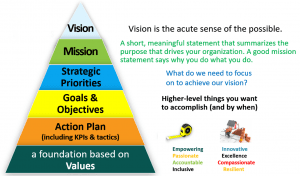Strategic Planning
Your Organization’s Roadmap to Future Success!
 So why does your nonprofit organization even need a strategic plan? Here are a few good reasons:
So why does your nonprofit organization even need a strategic plan? Here are a few good reasons:
- To set your direction and priorities.
A strategic plan sets the direction, establishes priorities for your organization, defines your organization’s view of success, and prioritizes your activities.
- To get everyone on the same page.
Once you’ve got your strategic direction defined, you can get everybody in your organization moving together to achieve your desired goals.
- To simplify decision-making.
A strategy aligned with your mission and goals keeps the focus on your priorities.
- To drive alignment.
Your staff and volunteers work hard, but they aren’t working on your strategic priorities. Your strategic plan should be the bus and your leadership the driver.
- To communicate the message.
When you have a written strategic plan, everyone can see where you’re going and understand their role in getting there.
Here are a few things to keep in mind when you’re getting started on your strategic plan:
- Keep it simple. You can make the greatest, slickest-looking strategic plan. Still, if it’s too complicated, or you can’t measure the results, it will probably sit on a shelf collecting dust.
- Keep it flexible. Your strategic plan needs to be a living, breathing guide to your organization’s success. You’ll want to review and make adjustments to it periodically. On the other hand, don’t make it so rigid that everything is carved in stone- adapt as needed.
- Keep your stakeholders engaged. Make sure the people who will be executing your plan are involved in the process of creating it. Buy-in is essential to carrying out your plan.
Six essential components will make up your Strategic Plan: vision, mission, strategic priorities, goals & objectives, values, and an action plan.
Here’s an outline of the basic steps you’ll most likely go through in creating your strategic plan:
- Identify your Steering Committee
- Form Your Strategic Planning Committee (SPC)
- Identify Stakeholders to Participate in the Process
- Interview Your Stakeholders
- Perform an Environmental Scan
- Compile and Distribute Your Data
- Prepare the Agenda and Activities for Your Planning Retreat
- Perform a SWOT Analysis
- Action Plan
Your final written strategic plan will summarize the results and decisions the strategic planning committee made over your strategic planning process and include the action plan.
Sound a bit overwhelming? Not sure how to get started?
No problem! Executive Service Corps- Florida and our team of consultants have many years of experience helping nonprofits through the process of creating their strategic plans. You can click here if you’d like to read a case study about a recent strategic planning process we helped Art and Culture Center Hollywood complete.
Schedule your free consultation to discuss a strategic plan for your organization by filling out the contact form below.
